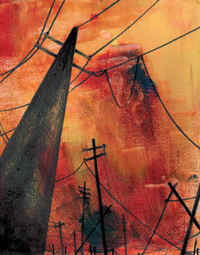


 |
 |
Issue Contents : : The Last Word
America after DarkFrom control systems to financing, the power structure in our country is ready for an overhaul.
 After the lights went out August 14, competing explanations were quick
to emerge. Canada blamed the United States. The United States blamed Canada.
And almost everyone, it seemed, blamed First Energy of Ohio, which supplies
electricity to much of the Midwest, including Oberlin. But the blame game
is still very premature. It will be a long time before investigations
determine what exactly caused the massive cascading power failure that
left millions in the dark.
After the lights went out August 14, competing explanations were quick
to emerge. Canada blamed the United States. The United States blamed Canada.
And almost everyone, it seemed, blamed First Energy of Ohio, which supplies
electricity to much of the Midwest, including Oberlin. But the blame game
is still very premature. It will be a long time before investigations
determine what exactly caused the massive cascading power failure that
left millions in the dark.
We should not be tempted to think that the results of an inquiry will prevent future blackouts. While we may determine the precise timeline of power failures and why they occurred, we will not likely agree on how to fix the system.
Part of the problem is this: the North American power system will always run as close to its limits as it can. It's true that investment in transmission capacity has not kept pace with electrical demand, but adding lines or capacity will only delay the problem. In an era of profit-driven electric companies, costly investments to the system will be put off as long as possible, despite rising demand. With that in mind, here are four fundamental characteristics of the electric power system that must be considered:
Power Systems Control and Protection:
Electricity flows along the path
of least resistance from areas of generation to areas of demand. Protection
devices
on the electric power system are designed to prevent damage to a transmission
line
or generator. These devices operate like the circuit breakers in your home,
which trip when a problem occurs in the power line. Your lights go out,
but
the wires
and your home appliances are protected from damage.
However, when this process is implemented on a transmission system--in other words, when a line becomes overloaded and is cut out of the "loop" by its protection system--the power must flow along other lines, which may then become overloaded, resulting in a domino effect that could lead to a full blackout. Alternative control systems place a higher priority on preventing blackouts or on re-directing power flows to aid components that are at risk. Such systems are being developed, but will require changes to the entire power infrastructure.
Complexity:
Even with improved control systems, the electric power grid
would remain a complex structure that behaves in ways that are nearly
impossible to predict. The system constantly changes as the generation
of power works
to keep
up with demand. Large portions of the grid are tightly coupled with each
other; changes in one area affect another. This complexity makes it difficult
to determine
in advance how upgrades and changes would affect the system.
Centralization:
Our current power system is based on large power plants
set in areas away from dense population. Smaller power plants located
close to
the power
demand--known as "distributed generation," or DG--can improve
overall reliability. Our research has shown that systems with significant DG
are better able to meet electricity demand, because the loss of any single generator
has a minimal effect. DG units can also be installed faster than large units
and in a variety of locations. During a blackout, DG can help carve the grid
into smaller, self-sufficient areas until the overall grid can be restored. However,
current regulations on installing and operating DG units are counterproductive
and eliminate many fundamental advantages of these smaller systems.
Institutional Structure:
During the past 20 years, the regulatory structure
of the electricity industry has changed at the federal and state
levels, causing a gradual and uneven transition from monopolies that
controlled
systems within
a given territory to a system of multiple actors competing to provide
power. On the physical level, the flow of electricity over the transmission
system
has
risen due to increased electricity trade for financial gain. At the
same time, the patchwork nature of the regulatory changes has reduced
incentives
to invest
in such costly infrastructure as transmission lines.
Some would argue that deregulation needs to be slowed down, or even reversed. Others believe that hesitant deregulation has created a complicated, expensive, and unreliable structure--and that deregulation must be accelerated.
Given the complexities and uncertainties of the power system, is there any hope of preventing blackouts and the economic damage they entail? It seems unlikely that blackouts will be eliminated completely. However, actions clearly need to be taken. More intelligent and adaptable control systems would help if they were implemented in a coordinated way. Simple mitigation measures, such as intelligent control of loads, can reduce the impact of blackouts so key facilities, such as traffic lights, are not paralyzed when most needed. Distributed generation could make the transmission system more reliable by alleviating short-term congestion. However, for any of this to happen, we must resolve the uncertainties surrounding deregulation in such a way that incentives exist to invest in and run the system in a way that is both efficient and robust.